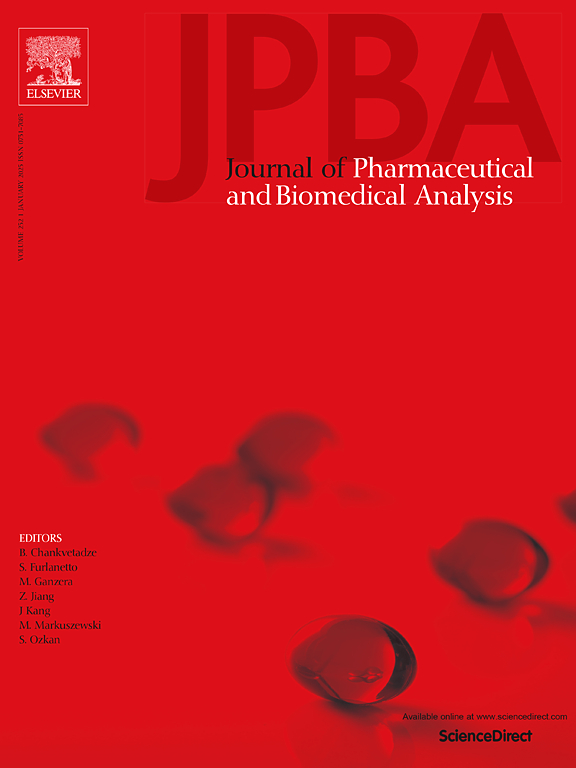2D-LC-Q-TOF /MS法鉴别盐酸米诺环素中有关物质
IF 3.1
3区 医学
Q2 CHEMISTRY, ANALYTICAL
Journal of pharmaceutical and biomedical analysis
Pub Date : 2025-04-03
DOI:10.1016/j.jpba.2025.116862
引用次数: 0
摘要
盐酸米诺环素是一种半合成的四环素衍生物,用途广泛。相关物质对其药效和安全性有重大影响。然而,对盐酸米诺环素或其产品中潜在相关物质的研究仍不全面。本文建立了一种可靠的二维液相色谱-四极杆飞行时间质谱(2D-LC-Q-TOF/MS)方法,用于分离和鉴定盐酸米诺环素片剂中的相关物质。根据色谱和质谱数据,确定了 17 种相关物质,包括工艺相关物质和降解产物。值得注意的是,其中 13 种相关物质是新发现的。提出了这些相关物质的形成机制,并系统地建立了盐酸米诺环素的降解途径。这些发现对盐酸米诺环素以及其他四环素类药物的质量控制很有帮助。本文章由计算机程序翻译,如有差异,请以英文原文为准。
Identification of related substances in minocycline hydrochloride via 2D-LC-Q-TOF /MS
Minocycline hydrochloride is a semisynthetic tetracycline derivative with a wide range of applications. The related substances significantly influence its efficacy and safety. However, the investigation of potential related substances in minocycline hydrochloride or its products remains incomplete. Herein, a reliable two-dimensional liquid chromatography-quadrupole time-of-flight mass spectrometry (2D-LC-Q-TOF/MS) method was developed for the separation and identification of the related substances in minocycline hydrochloride tablets. Seventeen related substances, including process-related substances and degradation products, were identified based on the chromatographic and mass spectrometric data. Notably, thirteen of these related substances were newly elucidated. Formation mechanisms of these related substances were proposed, and the degradation pathways of minocycline hydrochloride were systematically established. These findings are useful for the quality control of minocycline hydrochloride as well as other tetracycline drugs.
求助全文
通过发布文献求助,成功后即可免费获取论文全文。
去求助
来源期刊
CiteScore
6.70
自引率
5.90%
发文量
588
审稿时长
37 days
期刊介绍:
This journal is an international medium directed towards the needs of academic, clinical, government and industrial analysis by publishing original research reports and critical reviews on pharmaceutical and biomedical analysis. It covers the interdisciplinary aspects of analysis in the pharmaceutical, biomedical and clinical sciences, including developments in analytical methodology, instrumentation, computation and interpretation. Submissions on novel applications focusing on drug purity and stability studies, pharmacokinetics, therapeutic monitoring, metabolic profiling; drug-related aspects of analytical biochemistry and forensic toxicology; quality assurance in the pharmaceutical industry are also welcome.
Studies from areas of well established and poorly selective methods, such as UV-VIS spectrophotometry (including derivative and multi-wavelength measurements), basic electroanalytical (potentiometric, polarographic and voltammetric) methods, fluorimetry, flow-injection analysis, etc. are accepted for publication in exceptional cases only, if a unique and substantial advantage over presently known systems is demonstrated. The same applies to the assay of simple drug formulations by any kind of methods and the determination of drugs in biological samples based merely on spiked samples. Drug purity/stability studies should contain information on the structure elucidation of the impurities/degradants.

 求助内容:
求助内容: 应助结果提醒方式:
应助结果提醒方式:


